 |
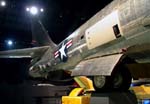 |
 |
 |
| 01 Boeing RB-47H Stratojet | 02 Boeing RB-47H Stratojet | 03 Boeing RB-47H | 04 Boeing RB-47H |
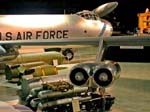 |
|||
| 05 Boeing RB-47H Stratojet |
Boeing RB-47H Stratojet Specifications:
Length: 108 feet 0 inches
Wingspan: 116 feet 0 inches - at the wing tips, the B-47's wings would flex as much as 17 feet!
Height: 28 feet, 0 inches
Crew: 3
Weight: Empty 76,000lbs Loaded - 125,000lbs
Max Speed: 610mph
Cruise Speed: 560mph
Range: 4,000 miles
Service Ceiling: 38,800 feet
Fuel Capacity: 17,000 gallons internal
Powerplant: Six General Electric J47 GE-25 turbojets 7,200 lbs thrust each
Armament:
Two 20mm cannons in the tail
20,000lbs internal ordnance
First Flight : 1955
Cost: $ 1,900,000
Rich Turck sent me a note in June of 2007 with a little background on what it was like to work on the B-47 as a Bomb/Nav technician. As a licensed A&P myself I found his experiences fascinating and have added it below with Rich's permission:
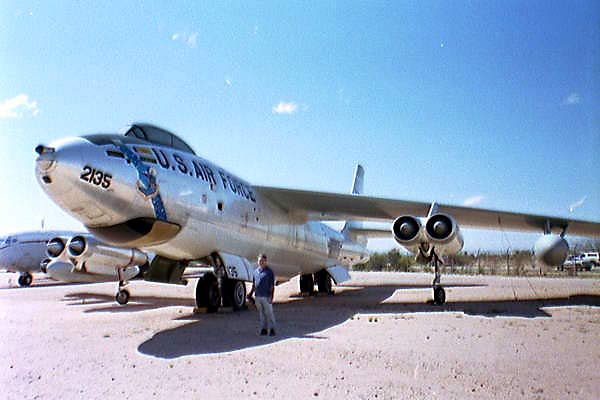 |
B-47 Bomb/Nav Technician Rich Turck poses with a Stratojet in Tuscon, AZ |
"Wow, your questions about the maintenance on the B-47 brought back memories that cause me to wonder why I have any affection whatsoever for that plane. NOTHING was installed conveniently. I was a Bomb/Nav technician, which was the 'computer'-driven, radar-assisted, bombing system. It was the primary electronic system that essentially was the reason for the B-47 itself. The system extended from the top of the tail, where the magnetic flux sensor was located, (to keep it isolated from electronic interference), to the glass periscope housing in the nose. So there were few places on that plane where I didn't venture.
Where to start. First, the computers were analog, i.e., gear-driven. When you took the case off one all you saw were clockwork type levers and gears of every size all turning at different speeds. There was no chance of repairing anything inside them while on the flight-line where we did most of our work. There were several that independently computed navigational position; target tracking; and bombing coordinates and timing elements effecting the bomb drop such as wind, time-of-fall, desired trail, (the distance you wanted to be away from the explosion), etc.
Some of the computers were installed in the Bombardier/Navigator's position in the nose of the a/c and some were outside just below the crew compartment and required a high-level maintenance stand to access. Everything was connected by cables and cannon plugs that all had to be safety-wired each time they were re-connected.
The radar system was primarily housed in the radome at the bottom of the nose and dropping the heavy, hinged radome from a wheeled stand was an adventure. The large antenna, (oddly, I recall that it was defined as a cosecant/squared, focused-beam antenna), rotated 360 degrees in the nav position, and then went into a narrow beam back/forth scan when the system was placed in the tracking/bombing mode. This dual-functionality allowed a single crew-member to perform both navigation and bombing tasks.
But basically, the first sign that the maintenance guy was never considered in the design is this. The first rung of the crew access ladder when lowered all the way was at best 3 feet above the ground. When the plane had a light fuel load it was even higher. So to try to gain that first step from an icy surface, (in my mind there was almost always snow & ice), with a black box that weighed 35-55 pounds was the cause of many injuries and lots of broken equipment.
When SAC ordered a Bar-None mission, it meant that every a/c included was to be airborne w/in timeframes that were minutes apart. So we sat in a maintenance van at the end of the runway in radio comm w/ the crews as they took turns launching. The nightmare started when a call came from the cockpit, "Bomb/Nav has no radar range marks. Get someone up here NOW!". One of us would run out & w/ 6 engines and a pilot screaming at us, climb into the cockpit w/ a small tool bag & a prayer that it was a switch position problem. To turn to the pilot & say, "It can't be fixed" was taking your life into your hands. You had about 10 seconds to get the hell out of his airplane or sit down and grab hold, 'cause they were going - NOW.
I laugh now.
One more interesting story. This one re: that seat (the Navigator's Ejection Seat the hatch is visible beneath the nose forward of the radar -Bill). It ejected downward. To prevent accidental ejection while on the ground they came up w/ a clever approach. When the ejection handle was pulled it triggered the release of the hatch rather than launching the seat rocket. The hatch was attached to the ejection seat trigger by a cable which after extending its length of approx. 15 feet, would activate the seat ejection sequence. The fact that the nav's position was approx. 10 feet from the ground ensured that in an accidental ground ejection sequence the hatch would strike the ground before the cable was fully extended. So the occupant might suddenly be hanging over an open hole, but would not be ejected.
That's exactly what happened on one occasion, and the occupant although frightened half to death carefully stepped out of the seat and down the ladder.
Of course all accidents are fully investigated and one investigator decided he wanted to see from below exactly what had happened. He put a stepladder under the hatch opening and began climbing. Perhaps he lost his balance, perhaps he simply needed support. In any case, he grabbed onto the still-activated cable to steady himself, and the ejection sequence was thus completed. The seat departed the A/C at 50 feet per second, just as advertised.
He did not file a report."
Rich wanted to add that these are memories of years past, but I have no reason to doubt him.
-------------------
Gerry Guay of CT who also was trained as a Boeing RB-47 Bomb-Nav Technician wrote with some insight on the bomber's Bomb-Nav System:
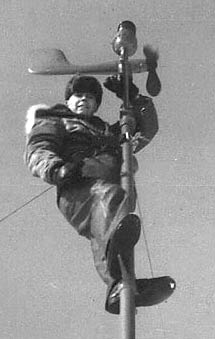 |
Gerry Guay, B-47 Bomb Nav Tech |
"I was looking at your web page for the RB-47 and read Rich Turck's article you posted. In 1959 I joined the Air Force with electronics as my field. I was assigned to the Bomb-Nav technician school at Lowry AFB, CO and did my basic electronics schooling there then the B-47 Bomb-Nav System School (K-MA-7A System) and graduated but before we graduated they said the field was over manned and they cross trained half the graduates in Auto-Pilot Technician and the other half into Weather Equipment Technician (at Chanute AFB, IL). After reading the article by Rick Turck, I am glad I got Weather Equipment. We had to troubleshoot to the electronic component, resistor, capacitor, etc. while in Bomb-Nav we troubleshot to the black box. Not only that, after leaving the AF after 8 years I was employed by a weather research firm and then we expanded to air pollution studies and measurements just in time for Environmental Protection which started in the early '70s. Anyway, I wanted to send you the flow diagram I have of the B-47 Bomb-Nav System. It was an amazing conglomeration of mechanical computers, radar, periscope, selsyns, tube amplifiers, relays, comparators, resolvers, gimbals, gears and many other units of all sorts. The picture is composed of a number of pictures assembled into one.
One of my websites is at http://gerrys.6thweathermobile.org and another at http://6thweathermobile.org "
Rich Turck had this to add after reading Gerry Guay's comments on the RB-47 Stratojet Bomb/Nav system flowchart:
"I was happy to read Gerry Guay's comments. I couldn't stop laughing, though at seeing his submission of the Bomb/Nav. system flow chart. When that chart, which was six feet long was issued to us we were ordered to go into Denver to buy a plastic golf-club tube to store it in because the flow chart was our maintenance bible. That Gerry still has his is testimony to the power of the word of our military seniors. After 50 years, mine is still safely rolled up in that original plastic tube.
You inquired as to whether sensitive, i.e., classified, information might be shown on the flow chart. They deliberately left off things like the operating frequency range of the radar's magnetron which was classified. The only other sub-system that was super-critical but was not classified was the stabilization computer that employed 3 axis-conflicting gyros to ensure a rock-steady platform that enabled a precise bombing solution. When you turned the system on you had to wait while the gyros spooled up to 24,000 revs and locked onto True North. You could then select the other functions – Navigate, Track, or Bomb.
I think that unit was unclassified because the AF guys felt that since the engineer who designed it supposedly went totally insane, chances of anyone attempting to duplicate his task would meet with the same fate. And there were times that I thought I had too."
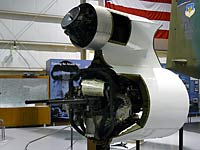 |
| RB-47 Tail Gun Turret at the Wings of Eagles Museum in Horseheads, NY |